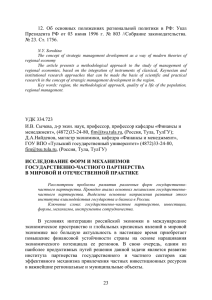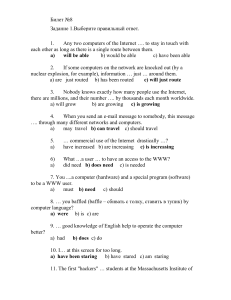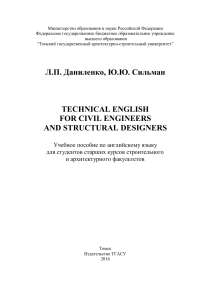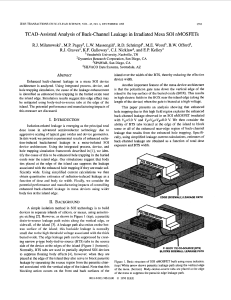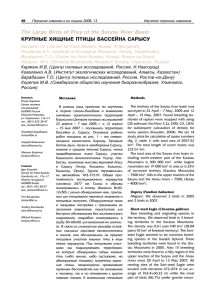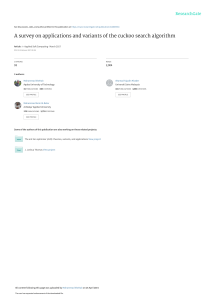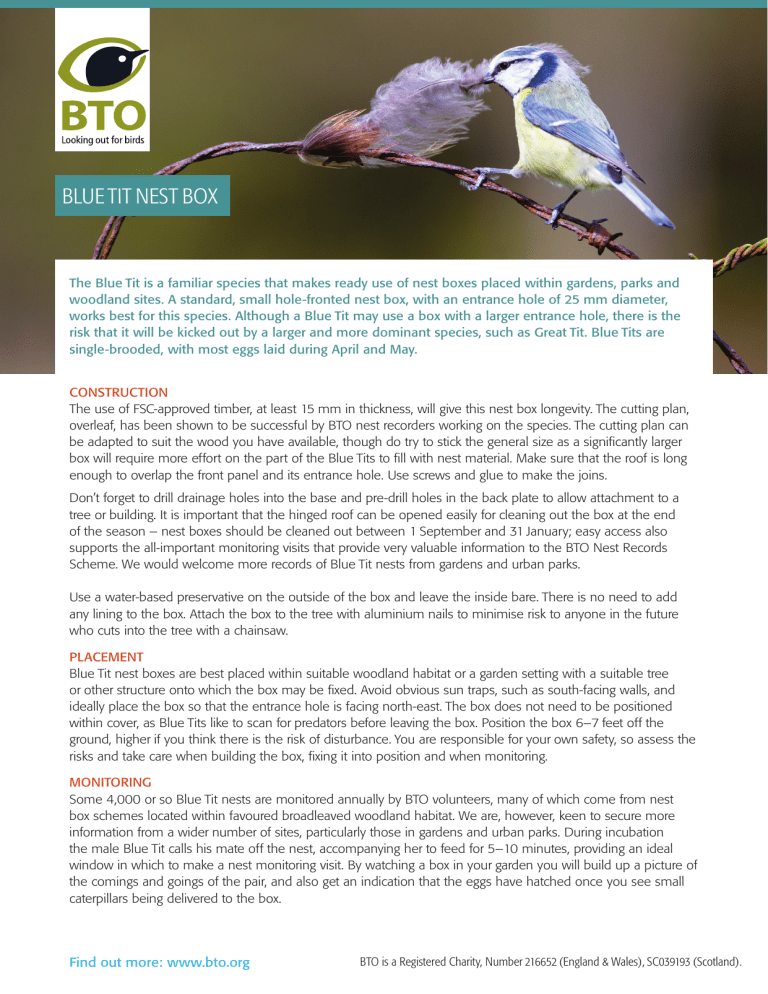
BLUE TIT NEST BOX The Blue Tit is a familiar species that makes ready use of nest boxes placed within gardens, parks and woodland sites. A standard, small hole-fronted nest box, with an entrance hole of 25 mm diameter, works best for this species. Although a Blue Tit may use a box with a larger entrance hole, there is the risk that it will be kicked out by a larger and more dominant species, such as Great Tit. Blue Tits are single-brooded, with most eggs laid during April and May. CONSTRUCTION The use of FSC-approved timber, at least 15 mm in thickness, will give this nest box longevity. The cutting plan, overleaf, has been shown to be successful by BTO nest recorders working on the species. The cutting plan can be adapted to suit the wood you have available, though do try to stick the general size as a significantly larger box will require more effort on the part of the Blue Tits to fill with nest material. Make sure that the roof is long enough to overlap the front panel and its entrance hole. Use screws and glue to make the joins. Don’t forget to drill drainage holes into the base and pre-drill holes in the back plate to allow attachment to a tree or building. It is important that the hinged roof can be opened easily for cleaning out the box at the end of the season – nest boxes should be cleaned out between 1 September and 31 January; easy access also supports the all-important monitoring visits that provide very valuable information to the BTO Nest Records Scheme. We would welcome more records of Blue Tit nests from gardens and urban parks. Use a water-based preservative on the outside of the box and leave the inside bare. There is no need to add any lining to the box. Attach the box to the tree with aluminium nails to minimise risk to anyone in the future who cuts into the tree with a chainsaw. PLACEMENT Blue Tit nest boxes are best placed within suitable woodland habitat or a garden setting with a suitable tree or other structure onto which the box may be fixed. Avoid obvious sun traps, such as south-facing walls, and ideally place the box so that the entrance hole is facing north-east. The box does not need to be positioned within cover, as Blue Tits like to scan for predators before leaving the box. Position the box 6–7 feet off the ground, higher if you think there is the risk of disturbance. You are responsible for your own safety, so assess the risks and take care when building the box, fixing it into position and when monitoring. MONITORING Some 4,000 or so Blue Tit nests are monitored annually by BTO volunteers, many of which come from nest box schemes located within favoured broadleaved woodland habitat. We are, however, keen to secure more information from a wider number of sites, particularly those in gardens and urban parks. During incubation the male Blue Tit calls his mate off the nest, accompanying her to feed for 5–10 minutes, providing an ideal window in which to make a nest monitoring visit. By watching a box in your garden you will build up a picture of the comings and goings of the pair, and also get an indication that the eggs have hatched once you see small caterpillars being delivered to the box. Find out more: www.bto.org BTO is a Registered Charity, Number 216652 (England & Wales), SC039193 (Scotland). BLUE TIT NEST BOX – CUTTING PLAN Plank size c. 150 x 1170 mm All measurements are in mm WEATHERPROOFING Weatherproof the roof with water-based preservative and ensure it overlaps the front of the box to stop rain reaching the entrance hole. ROOF JOINT To minimise the risk of rain entering the back of the box it is worth cutting a groove into the back plate to accommodate the back edge of the roof. ROOF BACK OPENING ROOF Fit a rubber hinge so that the roof can be lifted easily for cleaning and nest monitoring. Find our more about the BTO Nest Record Scheme on our website www.bto.org 175 300 200 150 25 mm diameter for Blue Tit and Coal Tit 120 SIDE 200 SIDE 175 200 175 FRONT ALTERNATIVE DESIGN An alternative to the traditional round entrance hole is a simple triangular opening on the side of the box. Overhang the roof if you adopt this approach. Get more information from our book ‘Nestboxes: your complete guide’. Available from www.bto.org BASE 150 Cover photograph: Edmund Fellowes / BTO; design artwork: Nigel Hawtin Blue Tit Cyanistes caeruleus Clutch size: 8–10 eggs Incubation: c.12 days Chicks fledge at: 16–22 days Broods: 1 per year Seasonality of nests with eggs (E) and young (y), derived from Nest Record Scheme data. J E Y F M A M J J A S O N D
